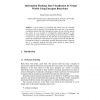Free Online Productivity Tools
i2Speak
i2Symbol
i2OCR
iTex2Img
iWeb2Print
iWeb2Shot
i2Type
iPdf2Split
iPdf2Merge
i2Bopomofo
i2Arabic
i2Style
i2Image
i2PDF
iLatex2Rtf
Sci2ools
VW
1998
Springer
1998
Springer
Information Flocking: Data Visualisation in Virtual Worlds Using Emergent Behaviours
A novel method of visualising data based upon the schooling behaviour of fish is described. The technique allows the user to see complex correlations between data items through the amount of time each fish spends near others. It is an example of a biologically inspired approach to data visualisation in virtual worlds, as well as being one of the first uses of VRML 2.0 and Java to create Artificial Life. We describe an initial application of the system, the visualisation of the interests of a group of users. We conclude that Information Flocking is a particularly powerful technique because it presents data in a colourful, dynamic form that allows people to easily identify patterns that would not otherwise be obvious.
Related Content
| Added | 06 Aug 2010 |
| Updated | 06 Aug 2010 |
| Type | Conference |
| Year | 1998 |
| Where | VW |
| Authors | Glenn Proctor, Chris Winter |
Comments (0)

